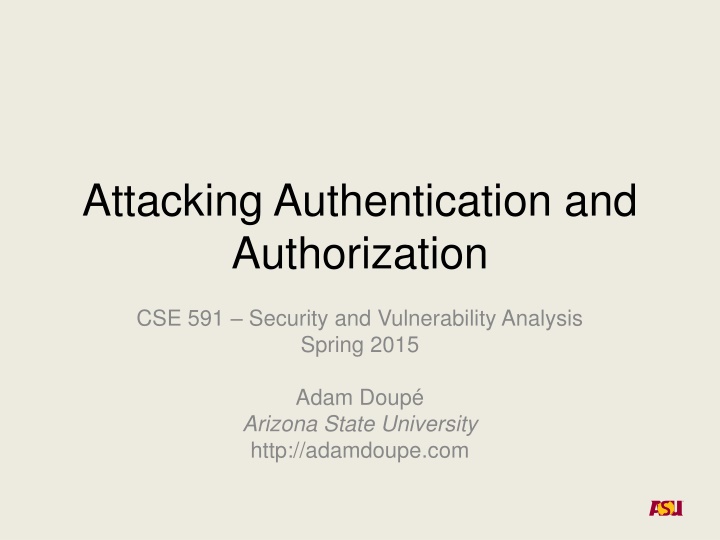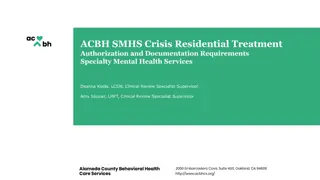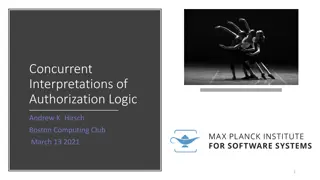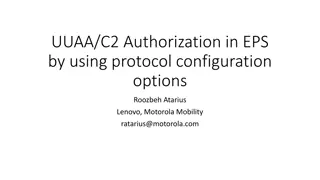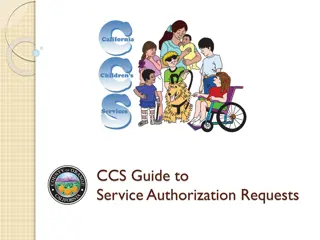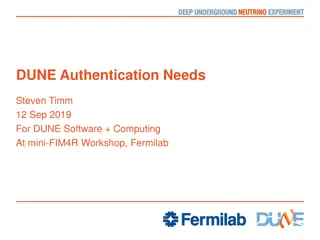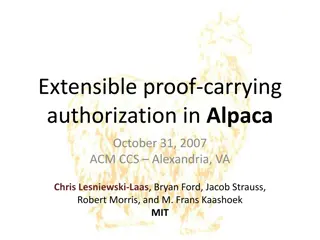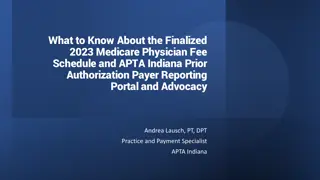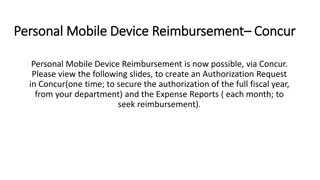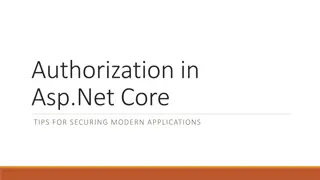Authorization
This content explores the concepts of authentication and authorization in security, emphasizing the importance of identifying users and determining their permissions. It covers topics such as eavesdropping on credentials, brute-forcing authenticators, and bypassing authentication methods.
Download Presentation

Please find below an Image/Link to download the presentation.
The content on the website is provided AS IS for your information and personal use only. It may not be sold, licensed, or shared on other websites without obtaining consent from the author.If you encounter any issues during the download, it is possible that the publisher has removed the file from their server.
You are allowed to download the files provided on this website for personal or commercial use, subject to the condition that they are used lawfully. All files are the property of their respective owners.
The content on the website is provided AS IS for your information and personal use only. It may not be sold, licensed, or shared on other websites without obtaining consent from the author.
E N D
Presentation Transcript
Attacking Authentication and Authorization CSE 591 Security and Vulnerability Analysis Spring 2015 Adam Doup Arizona State University http://adamdoupe.com
Definitions Authentication Who is the user? Breaking means impersonating another user Authorization What is the user allowed to do? Admin, regular, guest, Attacking means performing actions that you're not allowed to do Often intertwined If you're able to break the authentication to log in as a different user, then you've also broken authorization Adam Doup , Security and Vulnerability Analysis
Attacking Authentication Eavesdropping credentials/authenticators Brute-forcing/guessing credentials/authenticators Bypassing authentication SQL Injection (later) Session fixation Adam Doup , Security and Vulnerability Analysis
Eavesdropping Credentials and Authenticators If the HTTP connection is not protected by SSL it is possible to eavesdrop the credentials: Username and password sent as part of an HTTP basic authentication exchange Username and password submitted through a form The authenticator included as cookie, URL parameter, or hidden field in a form The "secure" flag on cookies is a good way to prevent accidental leaking of sensitive authentication information Adam Doup , Security and Vulnerability Analysis
Brute-forcing Credentials and Authenticators If authenticators have a limited value domain they can be brute-forced (e.g., 4-digit PIN) Note: lockout policies might not be enforced in mobile web interfaces to accounts If authenticators are chosen in a non-random way they can be easily guessed Sequential session IDs User-specified passwords Example: http://www.foo.bar/secret.php?id=BGH10110915103939 observed at 15:10 of November 9, 2010 Long-lived authenticators make these attacks more likely to succeed 5 Adam Doup , Security and Vulnerability Analysis
Bypassing Authentication Form-based authentication may be bypassed using carefully crafted arguments Authentication, in certain case can be bypassed using forceful browsing Weak password recovery procedures can be leveraged to reset a victim s password to a known value Session fixation forces the user s session ID to a known value For example, by luring the user into clicking on a link such as: <a href=http://foo.com/vulnerable.php?SESSIONID=1234>foo</a> The ID can be a fixed value or could be obtained by the attacker through a previous interaction with the vulnerable system 6 Adam Doup , Security and Vulnerability Analysis
Session Fixation (1) GET /login.py (2) session=4242 (3) GET /form.py?user=joe&pwd=foo&session=4242 (4) OK bank.com (4) GET /balance.py?session=4242 7 Adam Doup , Security and Vulnerability Analysis
Session Fixation Attacker (3) Attacker lures victim into clicking on http://bank.com/login.py?session=55181 bank.com Victim 8 Adam Doup , Security and Vulnerability Analysis
Session Fixation If the application blindly accepts an existing session ID, then the initial setup phase is not necessary Session IDs should always be regenerated after login and never allowed to be inherited Session fixation can be composed with cross-site scripting to achieve session id initialization (e.g., by setting the cookie value) See: M. Kolsek, Session Fixation Vulnerability in Web-based Applications 9 Adam Doup , Security and Vulnerability Analysis
Authorization Attacks Path/directory traversal attacks Break out of the document space by using relative paths GET /show.php?file=../../../../../../etc/passwd Paths can be encoded, double-encoded, obfuscated, etc: GET show.php?file=%2f%2e%2e%2f%2e%2e%2fetc%2fpasswd Forceful browsing The Web application developer assumes that the application will be accessed through links, following the intended paths The user, however, is not bound to follow the prescribed links and can jump to any publicly available resource Automatic directory listing abuse The browser may return a listing of the directory if no index.html file is present and may expose contents that should not be accessible 10 Adam Doup , Security and Vulnerability Analysis
Authorization Attacks Parameter manipulation The resources accessible are determined by the parameters to a query If client-side information is blindly accepted, one can simply modify the parameter of a legitimate request to access additional information GET /cgi-bin/profile?userid=1229&type=medical GET /cgi-bin/profile?userid=1230&type=medical Parameter creation If parameters from the URL are imported into the application, can be used to modify the behavior GET /cgi- bin/profile?userid=1229&type=medical&admin=1 11 Adam Doup , Security and Vulnerability Analysis
PHP register_global The register_global directive makes request information, such as the GET/POST variables and cookie information, available as global variables Variables can be provided so that particular, unexpected execution paths are followed 12 Adam Doup , Security and Vulnerability Analysis
PHP register_globals <html> <head> <title>Feedback Page</title></head> <body> <h1>Feedback Page</h1> <?php if ($name && $comment) { $file = fopen("user_feedback", "a"); fwrite($file, "$name:$comment\n"); fclose($file); echo "Feedback submitted\n"; } ?> <form method=POST> <input type="text" name="name"><br> <input type="text" name="comment"><br> <input type="submit" name="submit" value="Submit"> </form> </body> </html> Adam Doup , Security and Vulnerability Analysis
Example <?php if ($_GET["password"] == "secretunguessable1u90jkfld") { $admin = true; } if ($admin) { show_secret_admin_stuff(); } ?> Adam Doup , Security and Vulnerability Analysis
GET /example.php?password=foo&admin=1 <?php if ($_GET["password"] == "secretunguessable1u90jkfld") { $admin = true; } if ($admin) { show_secret_admin_stuff(); } ?> Adam Doup , Security and Vulnerability Analysis
Server (Mis)Configuration: Unexpected Interactions FTP servers and web servers often run on the same host If data can be uploaded using FTP and then requested using the web server it is possible to Execute programs using CGI (upload to cgi-bin) Execute programs as web application If a web site allows one to upload files (e.g., images) it might be possible to upload content that is then requested as a code component (e.g., a PHP file) 16 Adam Doup , Security and Vulnerability Analysis
Summary Attacks against Authentication and Authorization allow one to trick the web applications Thinking that you're someone else Giving you access to something that you shouldn't Adam Doup , Security and Vulnerability Analysis
